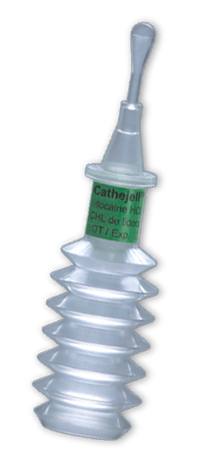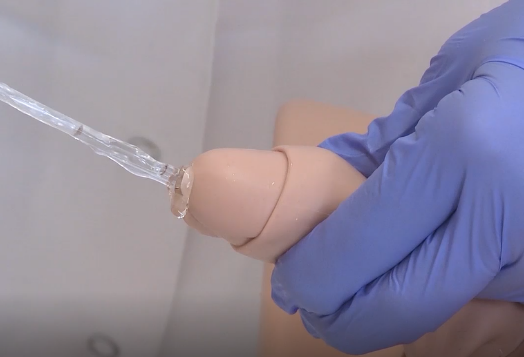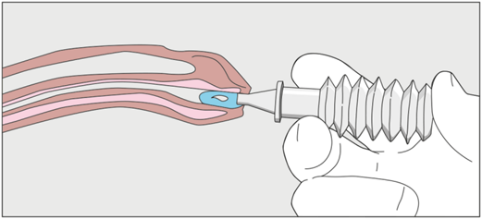Teaching Patients Self Catheterization1-5
Learning to intermittent self-catheterize (ISC) can be an intimidating task for a patient who has just learned that they will have to do this on a regular basis.
This should be explained to the patient as a routine procedure, an alternative continuation of a natural process, setting the expectations for success as part of a learning process. Mention that experience and practice will allow them to adopt this into their lives with little or no effect on their quality of life. To help alleviate any fears, assurances should be made that they will be supported and partnered with as they learn this aspect of bladder care.
To be most effective you should allow at least an hour for the first teaching session and allow lots of opportunity for questions.
During the session the following items should be discussed or reviewed:
- Description and step by step explanation of ISC,
- The basic anatomy and reason for ISC
- The physiological benefits of ISC
- The risk of urinary tract infections and what to do about them
- Educational resources available such as videos or pamphlets from companies
- Explanation and sample of a catheter similar to what they will be using
In terms of using a lubricating gel, the most commonly taught method has been for the patient to apply lubricating gel to the last 4-6 inches of a non-lubricated catheter. However, for some patients, such as male patients with BPH, known strictures or having had surgical interventions affecting the urethra, it may be of greater benefit to the patient to demonstrate how to instill lubricating gel directly into the urethra with a pre-filled syringe of 2% lidocaine gel such as Cathejell. Instillation of the gel directly into the urethra gently opens the normally closed urethra. When the catheter is inserted, it pushes the lubricating gel ahead of itself, opening the urethra and making a lubricated passage for the catheter to follow. This makes catheter insertion easier and reduces the risk of pain and injury.
Good perinatal care is important, and this should be stressed to the patient with simple soap and water applied to their genitalia. In a hospital demonstration, hospital policy may require an antiseptic clean, but that is not needed in a patient’s home.


Regarding inserting the catheter, a simple way to maintain sterility is to remove only a small portion of the catheter wrapping from both ends of the catheter.

Then insert the bladder end of the catheter into the urethra and then slowly slide the cover back with the same hand, then slowly advance the catheter, continuing this process until urine starts to flow and then remove the rest of the cover
Once the ISC process has been reviewed with and understood by the patient it is time to conduct a trial insertion by the patient under your supervision.
After the patient has accomplished self-catheterization, further discussion is necessary to understand the environment that they will normally be conducting this procedure in.
Equipment Needed for ISC
- Catheter
- Lubricating gel (ie Cathejell)
- Cleaning aids, such as a soapy washcloth, disposable towelettes (alcohol wipes), or unscented diaper wipes, to clean the urethra
- A clean dry towel to dry the urethral area
- A container to capture urine if it is to be recorded and measured
- Receptacle for catching/disposing of urine
- A mirror if required to see the urethral meatus
- A plastic bag or container to dispose of your towelettes and catheter
Possible Body Positions to Undertake ISC
- Sitting on a Toilet
- Standing over a toilet
- Sitting on a chair or on the side of the bathtub
- One leg slightly elevated on a stool
- Sitting in a wheelchair
- Lying on one side in bed
Teaching Female Catheterization
Locating the urinary meatus in a female is an essential skill. Since it is not readily visible for most women, try to train them to find it by touch. Separate the labia, then identify the vagina, then guide them upwards towards the clitoris. The meatus should be felt just below the clitoris, it feels a bit like a buttonhole. Some women have found a mirror to be a valuable aid to finding their urinary meatus. There are mirrors available for this purpose that clip onto a toilet, freeing up one hand and making it possible to see the meatus. Once they’ve found the meatus, have them repeat the process enough times that they can readily find it. Then have the patient insert the catheter until the urine begins to drain.
Once it’s drained, slowly pull the catheter out and dispose of it. While most female catheters are short like the female urethra, some women prefer the longer male style catheters as they are easier to handle and direct the urine into the toilet or a container.
Teaching Male Catheterization
With men the urethral meatus is usually found at the end of the dorsal side of the glans potion of the penis and is usually readily visible to the patient. The male urethra is much longer with a curving path that requires more care in navigating. Male patients should retract the foreskin over the glans, then hold their penis in their non-dominant hand, hold the penis at 30° to the body (towards the stomach) then apply traction to the penis to straighten the urethra and make it easier to insert the catheter. They should continue to insert the catheter until urine starts to flow then insert it a little further to make sure it is all the way into the bladder. They need to pass almost the entire length of the catheter. Once the urine stops flowing, slowly pull out the catheter, stopping if any more urine comes out then remove when the urine has stopped and dispose of it. If the foreskin has been retracted, have them pull it back over the glans.
Common Problems
Blood on catheter tip post catheterization:
This is caused by the catheter scraping the sensitive lining of the urethra on entry or removal and generally is not a cause for concern. If the bleeding is heavy or there are clots, then the damage is more significant, and the patient should seek medical attention.
Insertion or Removal Difficulties:
Men
They may have trouble passing the prostate or the bladder sphincter muscles. Relaxing, deep breathing or even coughing can help make this easier. If they are still unable to insert then they should seek medical help.
Females
A mirror may help those women who have some difficulty with finding the urinary meatus by touch. For those who have trouble holding their legs apart wide enough to access the meatus there are devices designed to spread and hold the legs apart that may be useful.
For more information on managing difficult or challenging patients, see the Catheterization Tips & Tricks Page
References
- Sheldon, P. (2013). Successful intermittent self-catheterization teaching: One nurse’s strategy of how and what to teach. Urologic Nursing, 33(3), 113-117. doi:10.7257/1053-816X.2013.33.3.113 McDermott P, Cooper B (2020)
- Teaching self-catheterisation in an emergency department. Nursing Times [online]; 116: 6, 32-35.
- Diane Newman, Intermittent Catheters – Teaching Self-Catheterization, UroToday,https://www.urotoday.com/urinary-catheters-home/intermittent-catheters/evidence-based-clinical/ic-clinical-and-research-publications/114455-intermittent-catheters-teaching-self-catheterization.html
- Ann Yates, 2017) Urinary catheters 4: teaching intermittent self-catheterisation. Nursing Times [online]; 113: 4, 49-51.
- Salma Balhi et al, Teaching patients clean intermittent self-catheterisation: Key points,02 December 2020, British J of Nursing, Volume 25, Issue 12, https://www.britishjournalofcommunitynursing.com/content/long-term-conditions/teaching-patients-clean-intermittent-self-catheterisation-key-points
Why Choose Cathejell for your Self-Catheterization Patients?
Desired Features and Benefits of Using a Pre-Filled syringe of 2% Lidocaine Anesthetic Lubricating Gel
| Features | Benefits |
|---|---|
|
Sterile, highly viscous (thick) gel. |
|
| Anesthetic included in sterile, highly viscous gel. |
|
| Low pressure syringe to instill gel slowly into the urethra. |
|
| Designed to be easy to open and use with one hand. |
|
| Smooth syringe tip for patient comfort. |
|
| Latex free, preservative free, chlorhexidine free. |
|
Choosing a Lubricant
The Importance of Lubrication When Catheterizing
The video explains the risks of having too little lubricating gel and how having enough can help reduce the risk of pain or injury.

Selecting A Lubricant For Self-Catheterization
Use of lubricant is an important choice for many people. You should understand how to select a good lubricant for catheterization. In the chart below are some of the things a good lubricating gel should have. Having the lubrication in a pre-filled syringe can make it easier to use, improve patient comfort and reduce the risk of injury.

Reasons for Using a Urethral Gel
- Dilating and lubricating the urethra improves ease of catheter entry and ability to maneuver it1
- Reducing pain from distension and friction
- Use of lidocaine gel further reduces pain
- Reducing the risk of urethral trauma
- May reduce risk for infection
- Reducing pain from distension and friction
- Lubricants adhere to mucosa creating a slippery barrier that reduces friction between urethra and catheters2
- Knowledge of lubricant and anesthetic reduces some patient pelvic tension
- Which may reduce urethral sphincter tension which if tense may cause catheter induced injury since the urethra may be compressed making it difficult to manipulate catheter3
- Aygin D, Usta E., The effect of lubricants used in indwelling bladder catheterization through urethra on procedure-related pain: a literature review, Int J Clin Exp Med 2017;10(2):1995-2005, www.ijcem.com
- Tzortzis et al, Intraurethral Lubricants-a Critical Literature Review and Recommendations, J of Endourology, vol 23, Number 5, May 2009 p821-82
- Carlos Villanueva, George Hemstreet III, Difficult Male Catheterization: A Review of Different Approaches, International Braz J Urol, vol 34 (4), 401: 412 July-Aug 2008
Benefits of Instillation with a Lubricant
There are two common lubrication methods to help put a catheter into the urethra:

1. Coating the outside of a catheter with lubrication before putting it into a urethra.
Coating only the outside or tip of the catheter with a lubricant may not be enough to protect the urethra from injury. This is because much of the lubricant is often pushed off the outside of the catheter as the catheter is pushed into the urethra. This means less lubricant is going into the urethra to protect the lining of the urethra.1
Once the catheter is inserted into the urethra, the portion of the urethra in front of the catheter is still closed. This means that the catheter must force the urethra to open. This results in an increased risk of pain from stretching the urethra with the catheter or injury from friction caused by the catheter and contact with the lining.4

2. Instilling lubrication directly into the urethra before putting the catheter in the urethra.
Putting lubrication into the urethra before inserting the catheter reduces the risk of injury to the delicate lining of the urethra.2,3 By putting the lubricant directly into the urethra it is possible to get a more even coating of the lining of the urethra with lubricant. Now the urethra which is normally closed, is gently opened by the lubricating gel and kept open in front of the catheter. This makes a lubricated path for the catheter to follow
References
- Tzortzis et al, Intraurethral Lubricants: A Critical Literature Review and Recommendations, Journal of Endurology, Vol 23, Number 5, May 2009 p 821-826
- Aygin D, Usta E, The effect of lubricants used in indwelling bladder catheterization through urethra on procedure-related pain: a literature review, Int J Clin Exp Med 2017;10(2):1995-2005, www.ijcem.com


 2476 Argentia Road, Suite 402
2476 Argentia Road, Suite 402 1.888.439.0013
1.888.439.0013 905.206.1413
905.206.1413 cathejell@biosyent.com
cathejell@biosyent.com